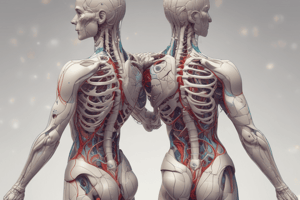Podcast
Questions and Answers
What are the two primary systems for body communication?
What are the two primary systems for body communication?
Nervous and Endocrine Systems
What are the two main parts of the nervous system?
What are the two main parts of the nervous system?
Central Nervous System (CNS) and Peripheral Nervous System (PNS)
What does the autonomic nervous system control?
What does the autonomic nervous system control?
- Sensory information
- Involuntary functions (correct)
- Motor commands
- Voluntary movements
What is the role of sensory neurons?
What is the role of sensory neurons?
The sympathetic system prepares the body for rest and digestion.
The sympathetic system prepares the body for rest and digestion.
What do myelin sheaths do?
What do myelin sheaths do?
What type of neuron connects neurons within the CNS?
What type of neuron connects neurons within the CNS?
The ___________ nervous system operates independently within the gastrointestinal tract.
The ___________ nervous system operates independently within the gastrointestinal tract.
What do nodes of Ranvier do?
What do nodes of Ranvier do?
What is the main body of the neuron called?
What is the main body of the neuron called?
Study Notes
Nervous System: Communication and Control
- The nervous system is one of the body's two primary communication systems, the other being the endocrine system.
- The nervous system is responsible for rapid communication, triggering immediate responses.
- The endocrine system controls slower, hormonal changes.
- The nervous system controls all bodily functions, including voluntary and involuntary actions like breathing, walking, and thinking.
Key Roles of the Nervous System
- Sensing: Gathers information from inside the body and the environment through sensory neurons.
- Integration: Processes and interprets information in the central nervous system (CNS). It uses past experiences to determine responses.
- Motor Function: Sends messages from the CNS to muscles and glands through motor neurons.
Central and Peripheral Nervous Systems
- Central Nervous System (CNS): Consists of the brain and spinal cord. Integrates sensory information and directs motor responses.
- Peripheral Nervous System (PNS): Comprises nerves outside the CNS. Acts as a communication pathway between the CNS and the rest of the body, further divided into the somatic and autonomic systems
Afferent and Efferent Pathways
- Afferent Pathway: Carries sensory signals from the body to the CNS.
- Efferent Pathway: Carries motor signals from the CNS to muscles and glands.
Somatic and Autonomic Nervous Systems
- Somatic System: Controls voluntary movements and responses to external stimuli like touch, temperature, and pain.
- Autonomic System: Controls involuntary functions such as heart rate, smooth muscle activity, and gland activity. This system is further divided into sympathetic and parasympathetic systems based on environmental demands.
Sympathetic and Parasympathetic Systems
- Sympathetic System: Prepares the body for intense physical activity by increasing heart rate, blood flow to muscles, and energy release while reducing non-essential functions like digestion. This is known as the "fight or flight" response.
- Parasympathetic System: Returns the body to a resting state by promoting functions like digestion, energy storage, and waste elimination. This is known as the "rest and digest" response.
Enteric Nervous System
- Enteric Nervous System: Operates independently within the gastrointestinal tract to control peristalsis (muscle contractions in the digestive system) and secretion of digestive enzymes without needing input from the CNS.
Anatomy of a Nerve
- Neurons: Electrically excitable cells that send and receive electrical impulses.
- Glial cells: Support and protect neurons. There are more glial cells than neurons.
- Sensory neurons: Respond to stimuli such as touch and sound.
- Motor neurons: Control muscles and glands.
- Relay neurons: Connect neurons within the CNS.
Neuron Structure
- Dendrites: Receive information and transmit signals to the cell body (soma).
- Soma: Contains the nucleus (containing DNA) and stores nutrients. It acts as a factory for the neuron.
- Axon: Transmits electrical signals to other neurons.
- Myelination: Schwann cells in the peripheral nervous system (PNS) produce myelin sheaths which insulate the axon and increase the speed of nerve signals.
- Nodes of Ranvier: Unmyelinated gaps in the axon that help signals jump quickly along the axon through saltatory conduction.
- Axon Terminals: Form connections (synapses) with the dendrites of other neurons allowing communication between nerve cells.
Neuroglia Cells
- Glial cells: Helper cells in the nervous system.
- Support Functions: Support, protect, insulate, and nourish neurons.
Studying That Suits You
Use AI to generate personalized quizzes and flashcards to suit your learning preferences.
Related Documents
Description
Explore the intricate functions of the nervous system, including its role in sensing, integrating, and executing bodily responses. Learn the differences between the central and peripheral nervous systems and how they work together to control voluntary and involuntary actions.




